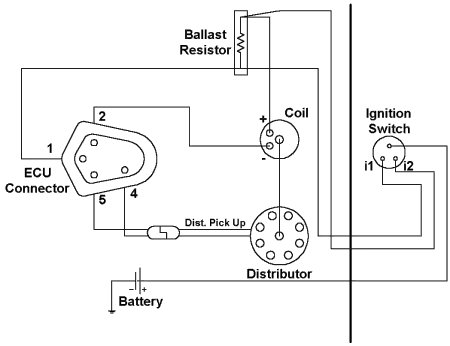|
Jensen Monday Club |
||||||||||||||||||
|
|
||||||||||||||||||
|
Starting in 1972, Chrysler began using a revolutionary new electronic ignition system. This system replaced the conventional points type distributor with a magnetic pickup coil and electronic control unit (ECU). This system eliminated routine maintenance and replacement of ignition components and provided better timing accuracy, more spark and higher RPM limits.This new ignition system introduced the electronic control unit (ECU), which was mounted to the bulkhead or inner wing. The distributor remained basically the same except for the pickup coil that was mounted in place of the points and the reluctor that replaced the rotor. The distributor retained the same housing and vacuum advance system that was used on points type ignition systems. The theory of operation is very simple. The reluctor is similar to the rotor of a points type system, except it has vertical vanes that protrude from the side. As the distributor turns, these vanes pass very close to the core of the pickup coil. This induces a small electrical pulse into the coil, which is sent to the ECU. The ECU acts as an amplifier for these pulses and in turn sends a much larger pulse to the ignition coil. The coil acts the same way as in a points type system and produces the high voltage needed to fire the spark plugs. ApplicationChrysler's electronic ignition was used on all 1973 and '74 vehicles and on 1975 and newer vehicles that did not use Electronic Lean Burn, or Electronic Spark Control. Because Chrysler engineers chose to make the electronic ignition system a drop-in replacement when it was introduced, it is very easy to adapt it to earlier vehicles or those later vehicles that did not originally use it. Many owners are faced with having to deal with less than ideal ignition systems, especially those who own mid to late 70's or early 80's V8 powered Chrysler products. Cars of this era were largely equipped with what Chrysler originally called Electronic Lean Burn. It was supposed to be the next great advancement in electronic ignition control. It was a computerised system that took input from various sensors and then used pre-programmed data for delivering precise ignition timing. Unfortunately, it was plagued with over-complexity and the poor choice of attaching the electronics to the side of the air cleaner. This location subjected the control computer to excess heat and vibration, which often led to failure. Whether you are converting an earlier ignition system, replacing Lean Burn, or repairing an existing electronic ignition system, the work is not at all difficult. Because the electronic ignition system used only a few components, it is easy to work with and troubleshoot. The requirements for installing an electronic ignition system are as follows:
Fortunately, Mopar Performance has made it easy to buy most of what you need in a complete kit. Kits are available for the following applications:
TroubleshootingTroubleshooting an electronic ignition system is fairly simple. Once it has been determined that there is no spark, there are a few quick checks that can be performed to determine the cause. A DC volt/ohm meter can be used to check the continuity of the pick-up coil. It can be checked at the leads as they leave the distributor, or on pins 4 and 5 of the ECU connector. When measuring the resistance across the two leads of the pick-up coil you should see a 150-900 ohm reading. Always flex the wiring leading to the distributor and to the ECU while checking the resistance to be sure that there are no breaks in the wiring. You should also check for 12 volts at pin 1 of the ECU connector when the ignition is in the "on" position. It is also important that the ECU be securely bolted in place and that bolts provide a good ground to the ECU housing. The only other lead that is connected to the ECU is the "-" lead to the coil, which can be checked to insure that it is not broken.
The other important component of the electronic ignition system is the ballast resistor. It should be checked with an ohm meter and should have 1.2 ohms of resistance. Typically, a failure of the ballast resistor will result in the engine starting, but then dying as soon as the key is released from the start position. It is often handy to have a spare ballast resistor or ECU lying around to use for troubleshooting. Upgrading or replacing an existing systemWhen replacing a points type system, you will need the wiring harness that goes with the electronic control unit. The installation is fairly simple and the only electrical connection that needs to be made is to the ignition "+" circuit. If you are replacing an Electronic Lean Burn or Electronic Spark Control system, there are several other things to be considered. While these systems are of themselves, electronic ignition, they do not use the same components as the regular electronic ignition system. The spark advance was being generated by the computer, therefore the distributors lack vacuum and mechanical advance. Many of these distributors also have two pick-up coils and are not usable with a regular electronic ignition system. Additionally, the carburettors that were equipped on these cars may lack a vacuum advance port for a conventional distributor and often need to be re-calibrated for use without the computer.
|
||||||||||||||||||
